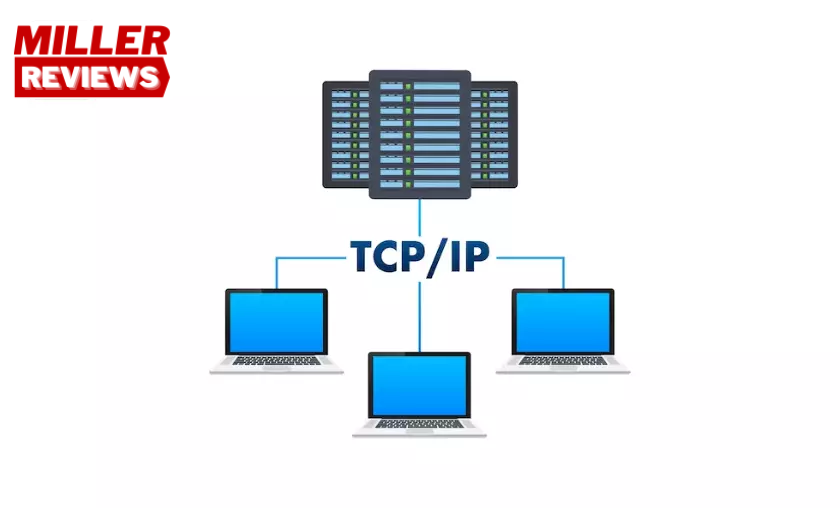Welcome to computer networks, where much data flows ceaselessly, exchanging hands and being accessed at every turn. Behind the scenes, an intricate system of protocols orchestrates this communication, ensuring it unfolds seamlessly and efficiently. To truly comprehend the intricacies of networking, one must grasp the inner workings of these protocols. This blog post unravels the mysteries surrounding three indispensable networking protocols: TCP/IP, DNS, and DHCP.
Networking Protocols
TCP/IP (Transmission Control Protocol/Internet Protocol) is at the foundation of Internet communication. It serves as the bedrock, defining how data is meticulously divided into packets, traverses networks, and reunites at its intended destination. By unraveling the essence of TCP/IP, we gain invaluable insight into the core of Internet communication, comprehending how devices establish connections and interact.
Another essential protocol, DNS (Domain Name System), bears the moniker “phonebook of the Internet.” It undertakes the crucial task of translating human-friendly domain names (such as www.example.com) into their corresponding IP addresses. This translation process is vital for web browsers, email servers, and various applications, enabling them to locate the correct servers and resources on the vast internet. By shedding light on the inner workings of DNS, we begin to fathom how our simple web requests metamorphose into IP addresses, facilitating effortless access to websites and services.
Simplifying network configuration is the domain of DHCP (Dynamic Host Configuration Protocol), which dynamically assigns IP addresses to devices. DHCP servers take charge of this allocation and management, eliminating the need for manual configuration. Understanding DHCP ensures that networks efficiently give IP addresses, enabling devices to connect harmoniously and exchange information seamlessly.
As we embark on this journey of demystifying networking protocols, we can unlock the secrets behind network communication and effectively troubleshoot connectivity issues. In the following sections, we shall delve into each protocol, meticulously exploring its functionalities, intricate interactions, and vital considerations regarding security. Prepare to venture into the captivating world that powers our interconnected digital landscape.
Table of Contents
The Foundation Of Internet Communication

TCP/IP (Transmission Control Protocol/Internet Protocol) drives data transmission across networks. It encompasses a comprehensive suite of communication protocols that establish connections, facilitate data exchange through packets, and ensure reliable and efficient delivery. As the backbone of the internet, TCP/IP enables seamless communication between countless devices scattered across the globe.
Unraveling the Layers of the TCP/IP Protocol Suite

The TCP/IP protocol suite is structured into multiple layers, each serving distinct functions in the communication process. These layers harmoniously work together, simplifying network communication and promoting flexibility and interoperability. The critical layers of TCP/IP include the application, transport, internet, and network interface layers.
Exploring the Role of TCP and UDP in Data Transmission

Within the transport layer of TCP/IP reside two notable protocols: TCP (Transmission Control Protocol) and UDP (User Datagram Protocol). TCP offers reliable and connection-oriented communication, ensuring precise and sequential data delivery. On the other hand, UDP operates connectionless, delivering data swiftly but with less reliability. This makes UDP ideal for applications that prioritize speed over absolute accuracy.
Understanding IP Addressing and Routing

The internet layer of TCP/IP focuses on addressing and routing. It employs IP (Internet Protocol) to assign unique IP addresses to devices connected within a network, enabling their identification and location. IP addresses are vital for effective data routing, guaranteeing efficient delivery of packets to their intended destinations.
TCP/IP & the Internet: A Seamless Connection

The ubiquity of TCP/IP as the standard protocol suite for internet communication has revolutionized global connectivity. Its adoption has facilitated seamless interoperability between devices and networks from various vendors, empowering the exchange of information on an unprecedented scale. The robustness, versatility, and scalability of TCP/IP have been instrumental in fueling the growth and triumph of the internet.
DNS: Decoding the Domain Name System
DNS, an indispensable protocol, is pivotal in transforming user-friendly domain names into their corresponding IP addresses. Functioning as the revered “phonebook of the internet,” DNS empowers users to access websites and services using familiar domain names effortlessly. In this blog post, we will embark on a journey to unravel the inner workings of DNS, delving into its operational mechanisms, hierarchical structure, the intricacies of DNS resolution, and the impact of DNS caching on web performance. Understanding DNS is crucial for comprehending the complexities of internet communication and gaining a holistic grasp of other networking protocols such as TCP/IP and DHCP.
Introducing DNS

Consider DNS as the robust foundation of the internet’s naming system. It operates as a decentralized and distributed database, translating easily memorable domain names (like www.example.com) into machine-readable IP addresses (such as 192.0.2.1). By leveraging the power of DNS, users can effortlessly access websites and online services without the burden of memorizing the specific IP addresses associated with each destination. DNS eliminates the need to grapple with complex numerical strings, making the internet more accessible and user-friendly.
Demystifying the Translation of Domain Names to IP Addresses
The translation process within DNS unfolds through a hierarchical system. At the apex, we find generic top-level domains (gTLDs) like .com and .org, alongside country-code top-level domains (ccTLDs) such as .uk and .fr, representing different categories of websites. Authoritative name servers govern these top-level domains. When a user inputs a domain name, DNS diligently queries the relevant authoritative name server to retrieve the corresponding IP address.

This query follows a recursive journey, starting from the root name servers, cascading down to the top-level domain servers, and ultimately reaching the authoritative name server for the specific domain. This hierarchical structure guarantees domain names’ efficient and accurate resolution to their corresponding IP addresses.
The DNS resolution process encompasses various steps, including caching, where DNS resolvers temporarily store resolved mappings to enhance future response times. DNS caching reduces the need for repeated queries, optimizing web performance and alleviating network traffic. However, caching also introduces the possibility of outdated information if changes occur in IP address mappings. Thus, DNS caching must strike a delicate balance between performance and accuracy, ensuring smooth and reliable navigation of the digital landscape.
DHCP: Simplifying Network Configuration
DHCP, an acronym for Dynamic Host Configuration Protocol, emerges as a prevalent network protocol, revolutionizing the intricate process of configuring and managing IP addresses within a network. Its primary purpose revolves around streamlining the allocation of IP addresses and other essential network configuration parameters, such as subnet masks, default gateways, and DNS server addresses, to devices operating within a network. By embracing DHCP, the arduous task of manual IP address configuration, which can be time-consuming and prone to errors in expansive networks, becomes a thing of the past.
Dynamic IP allocation: The role of DHCP servers

Network administrators gain centralized control and management over IP address distribution. A DHCP server takes center stage, meticulously maintaining a pool of available IP addresses and dynamically assigning them to devices as they join the network. This dynamic allocation ensures optimal utilization of IP addresses, as addresses no longer in use can swiftly be reallocated to other devices, fostering efficiency within the network ecosystem.
DHCP lease process: Obtaining & renewing IP addresses

The DHCP lease process encompasses a series of well-orchestrated steps. It commences with a device broadcasting a DHCP discover message, eagerly seeking available DHCP servers within the network. Responding to the plea, the server offers an IP address lease and other configuration parameters via a DHCP offer. The device, keen to claim the submitted IP address, sends a DHCP request, formally requesting its allocation. In response, the server issues a DHCP acknowledgment, solidifying the lease and confirming the device’s rightful place within the network.
DHCP options: Enhancing network configurations

One remarkable advantage of DHCP lies in its flexibility when configuring and enhancing network settings through DHCP options. These options unlock the capability to include additional parameters in the DHCP server’s response. This versatility empowers administrators to assign specific DNS servers, specify time servers, or even provide customized vendor-specific settings, ensuring the network configuration aligns precisely with the desired requirements.
DHCP vs. static IP: Pros and cons
When deliberating between DHCP and static IP addressing, weighing the pros and cons of each approach is essential. DHCP stands tall in terms of convenience and scalability, as it automates the management of IP addresses, making adding or removing devices from a network effortless. It also effectively mitigates the risk of address conflicts. However, DHCP necessitates an available DHCP server and can introduce a slight overhead regarding network traffic and potential delays during the lease renewal process. Static IP addressing, on the other hand, offers fixed and predictable IP addresses, a boon for devices requiring consistent addressing or services reliant on specific IP configurations. Yet, it demands manual design and active management to avert address conflicts that may arise.
The Interplay of TCP/IP, DNS & DHCP
TCP/IP, DNS, and DHCP are indispensable networking protocols that form the backbone of communication and network configuration. TCP/IP, which stands for Transmission Control Protocol/Internet Protocol, is the entire protocol suite for data transmission across the Internet and local networks. It governs the intricate process of breaking data into packets, addressing them, routing them across networks, and seamlessly reassembling them at their intended destinations.

DNS, the Domain Name System, is at the heart of TCP/IP communication. DNS plays a pivotal role by translating human-readable domain names into corresponding IP addresses. When a user enters a domain name in a web browser, the DNS system resolves the name to its associated IP address. This translation allows data to be accurately transmitted to the correct destination. DNS servers diligently maintain a distributed database of the domain name and IP address mappings, enabling devices to effortlessly locate the precise IP address associated with any domain name.
Complementing TCP/IP, DHCP (Dynamic Host Configuration Protocol) streamlines the process of IP address assignment within TCP/IP networks. DHCP servers automate the allocation of IP addresses to devices, eradicating the need for manual configuration. When a device connects to the network, it broadcasts a DHCP request to discover available DHCP servers. In response, the server promptly assigns an IP address lease along with other essential network configuration parameters, enabling the device to integrate seamlessly into the network without manual intervention. DHCP significantly simplifies network administration and ensures efficient management of IP addresses.
In TCP/IP networks, challenges can arise concerning connectivity, DNS resolution, and IP conflicts. Troubleshooting connectivity issues involve:
- Meticulous analysis of network configurations.
- Examining both physical and logical aspects.
- Verifying the proper design of TCP/IP protocols.
DNS resolution problems may emerge if the DNS server malfunctions, the domain name is misspelled, or network connectivity between the client and the DNS server encounters obstacles. IP conflicts can occur when multiple devices on the network are assigned the same IP address, leading to communication issues. Addressing these concerns typically entails checking DHCP lease information, confirming DNS server settings, and resolving IP conflicts by reassigning unique IP addresses to affected devices.
Security Considerations & Best Practices
Security considerations and best practices must be considered regarding the essential protocols of TCP/IP, DNS, and DHCP. While these protocols are vital for network communication and configuration, they also introduce vulnerabilities that must be addressed to uphold the security and integrity of the network.

Attackers can exploit TCP/IP, DNS, and DHCP protocols to gain unauthorized access, manipulate or intercept data, and disrupt network operations. To counter these security risks, implementing various measures is crucial. One key aspect is the deployment of firewalls, acting as a protective barrier between the internal network and external threats. By filtering incoming and outgoing network traffic, firewalls can block unauthorized access and thwart potential attacks.
Encryption plays a significant role in protecting sensitive data during transmission. Implementing protocols like Transport Layer Security (TLS) or Secure Sockets Layer (SSL) ensures that data exchanged between devices is encrypted, rendering it inaccessible and unalterable to unauthorized individuals.
In the realm of DNS, DNSSEC (DNS Security Extensions) assumes a critical role in addressing security concerns. DNSSEC provides a mechanism for validating the authenticity and integrity of DNS responses, mitigating the risks associated with DNS cache poisoning attacks and domain hijacking.
Intrusion detection systems (IDS) offer additional protection by continuously monitoring network traffic and identifying potential security breaches or suspicious activities. IDS can detect unauthorized access attempts, unusual traffic patterns, or known attack signatures, enabling swift response and mitigation.
Adhering to best practices is paramount to establishing secure TCP/IP, DNS, and DHCP configurations. This includes:
- Regularly updating software and firmware to patch known vulnerabilities.
- Utilizing solid passwords and implementing multi-factor authentication.
- Restricting access to critical network components.
- Employing secure protocols and encryption whenever feasible.
Addressing security concerns and implementing best practices is essential for securing TCP/IP, DNS, and DHCP protocols. By leveraging firewalls, encryption, DNSSEC, intrusion detection systems, and following security best practices, network administrators can significantly enhance the security posture of their networks and fortify themselves against potential threats and attacks.
Future Trends & Emerging Technologies
The future of networking protocols is shaped by a multitude of emerging technologies and trends that hold the potential to reshape the landscape of TCP/IP, DNS, and DHCP.
One notable trend is the widespread adoption of IPv6 (Internet Protocol version 6) as the successor to IPv4. With its significantly larger address space, IPv6 enables a virtually limitless number of unique IP addresses. This transition to IPv6 will have far-reaching implications for TCP/IP, DNS, and DHCP protocols, as they need to support and adapt to the new addressing scheme. Network administrators and organizations must ensure their infrastructure, software, and devices are IPv6-compatible to fully leverage its benefits, such as improved scalability, enhanced security features, and support for emerging technologies like the Internet of Things (IoT).

In the realm of DNS, emerging technologies such as DNS over HTTPS (DoH) and DNS over TLS (DoT) are gaining prominence. These protocols offer additional privacy and security by encrypting DNS queries and thwarting potential eavesdropping or tampering with DNS traffic. DoH and DoT safeguard user privacy, as DNS queries are no longer transmitted in plaintext. These protocols mitigate the risks of DNS spoofing or manipulation, fostering a more secure and private browsing experience. As their adoption continues to rise, we expect their increased implementation across various applications and devices.
Software-defined networking (SDN) is yet another technology shaping network protocol’s future. SDN decouples the control plane from the data plane, dynamically enabling network administrators to manage and configure networks through centralized control. This shift towards software-based network management could influence the traditional implementations of TCP/IP, DNS, and DHCP protocols. SDN offers greater flexibility, scalability, and automation in network configuration, making it easier to adapt to evolving network demands and optimize performance.
As we look ahead, the convergence of these emerging technologies and trends will undoubtedly profoundly impact the future of TCP/IP, DNS, and DHCP protocols. Network administrators and organizations must stay abreast of these developments, embracing IPv6 compatibility, adopting secure DNS protocols, and exploring the potential of software-defined networking to ensure their networks are prepared for the evolving demands of the digital landscape.
Conclusion
A solid understanding of TCP/IP, DNS, and DHCP protocols is crucial for expanding your networking knowledge and effectively managing network configurations. These protocols are the foundation of modern network communication, facilitating IP addressing, data transmission, domain name resolution, and network configuration.
TCP/IP acts as the framework for transmitting data, while DNS translates user-friendly domain names into corresponding IP addresses, and DHCP automates IP address assignment. By comprehending how these protocols interact, you can optimize network performance, streamline network management, and bolster security.
Moreover, keeping abreast of emerging trends and technologies in networking protocols, such as IPv6, DNS over HTTPS (DoH) and DNS over TLS (DoT), and software-defined networking (SDN), will equip you to embrace the future of networking. This knowledge ensures your network infrastructure remains secure, efficient, and adaptable. By mastering TCP/IP, DNS, and DHCP, you’ll confidently navigate the intricacies of networking and make well-informed decisions to construct and maintain robust and dependable networks.
For More amazing articles related to Tech Check out our website Over Here
To Read more similar articles click here
Thanks for visiting our Website. If you appreciate our work, kindly show us some support in our comments section 🙂